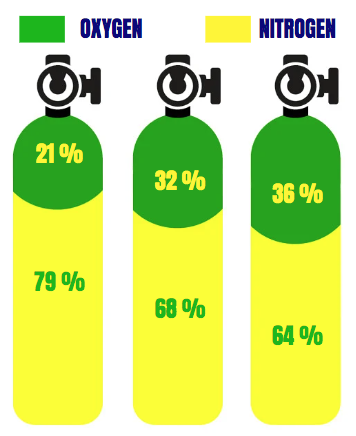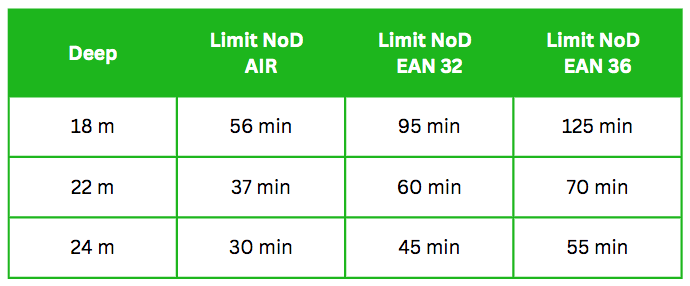Last updated: 5 May 2024 | 3887 Views |


NITROX refers to any gas mixture composed (except trace gases) of nitrogen and oxygen. This includes atmospheric air, approximately 78% nitrogen, 21% oxygen, and 1% other gases, primarily argon. In the usual application, underwater diving, nitrox is normally distinguished from air and handled differently.
NITROX gas mixture is nothing new and has been in use under differing names since before the Second World War. The history and development is well known and risks associated with well documented. NOAA is perhaps the best known authority and has developed tables and working parameters that are still in use and followed today
NITROX can Reduce the proportion of nitrogen by increasing the proportion of oxygen, reduce the risk of decompression sickness for the same dive profile, or allow extended dive times without increasing the need for decompression stops for the same risk.
The significant aspect of extended no-stop time when using nitrox mixtures is reduced risk in a situation where breathing gas supply is compromised, as the diver can make a direct ascent to the surface with an acceptably low risk of decompression sickness. The exact values of the extended no-stop times vary depending on the decompression model used to derive the tables, but as an approximation, it is based on the partial pressure of nitrogen at the dive depth. This principle can be used to calculate an equivalent air depth (EAD) with the same partial pressure of nitrogen as the mix to be used, and this depth is less than the actual dive depth for oxygen enriched mixtures. The equivalent air depth is used with air decompression tables to calculate decompression obligation and no-stop times.

The best application of nitrox is in the 50- to 100-foot range. No stop times for dives shallower than 50 feet are often so long that you'll empty your tank before you run out of dive time. Using EANx36 at 60 feet, your no stop limit is 80-90 or more minutes (depending on your computer) for your first dive, so you'll again be limited by your gas supply, not your decompression limit.
You were taught to dive well within limits, and by pushing the limits outward, you can dive longer and still be conservative. Many enjoy nitrox diving to or even beyond air limits without being anywhere near the actual no stop max. As with air, this doesn't guarantee 100 percent safety, but staying well within limits reduces practical DCS risk for most divers.

The U.S. Navy and the National Oceanic and Atmospheric Administration (NOAA) say standard scuba equipment can be used for oxygen concentrations up to 40 percent. Since this is also the maximum recreational limit for nitrox diving, there has never been gear-related incident recreational diving equipment used within recreational nitrox limits. (Note: Some manufacturers use a more conservative rule. Always follow a manufacturer's recommendations for their gear.)
Contrary to popular belief, oxygen does not burn. It does, however, enhance the flammability of everything that it contacts—the higher the concentration of oxygen, most substances ignite more easily and burn hotter and more rapidly. For this reason, there is one equipment exception and that is the scuba tank, for two main reasons.
One reason is that a common method of making nitrox (especially custom mixes) requires putting pure oxygen in the tank first, followed by specially filtered oxygen-compatible air second. Because the tank contains pure oxygen during blending, they must meet oxygen service standards, which means the materials (o-rings, valve seats) and any lubricants must be rated for use with pure oxygen. The tank must also be specially cleaned, which is done annually.
The second reason, as you learned, is that the tank must be clearly marked so it is not accidentally dived as air. The distinctive EANx band is at the top of the cylinder so it is visible, even when surrounded by a cluster of cylinders
This benefit does not come without some cost. Oxygen, while useful and essential to life, can become hazardous in high concentrations. Too much oxygen at pressure affects the central nervous system – oxygen toxicity – causing convulsions or seizures, visual distortions, ringing ears, nausea, twitching, irritability and dizziness, with convulsions or seizures being the most serious while diving. Oxygen toxicity hits are very rare in diving, but if they happen under water, they happen without warning and lead to drowning if you lose the regulator while convulsing. Any percentage of oxygen can cause toxicity if you go deep enough, but with air you have to go well beyond established depth limits for this to be likely. With nitrox, the depth limit is within recreational diving depths, and the more oxygen, the shallower the limit – the limit is the depth at which the PPO2 would be 1.4 ata. Long term exposure to elevated oxygen can cause a different type of oxygen exposure as well. Earning a nitrox certification is required because, among other issues, EANx divers must learn now to manage their oxygen exposure.
RAID NITROX course includes With Free E- Learning that can be completed in a few short hours. In-person learning or Be with a group of your friends. Can done in a day on the boat. It gives you Various setup methods during class: Analyze a tank and set your dive computer for nitrox with a RAID Instructor there to guide you.